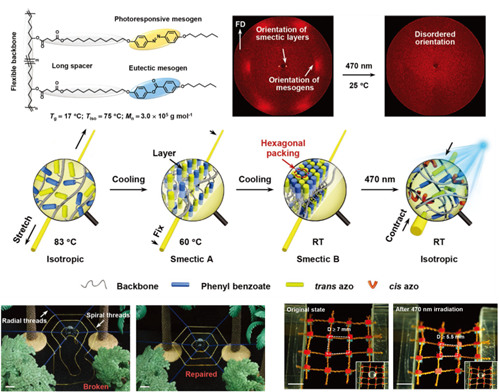Search
Title: Ultralarge Contraction Directed by Light-Driven Unlocking of Prestored Strain Energy in Linear Liquid Crystal Polymer Fibers
Author: Xinlei Pang, Lang Qin, Bo Xu, Quan Liu, Yanlei Yu*
Journal: Adv. Funct. Mater., 2020, 30(32), 2002451
Abstract:
Anisotropic 1D contraction motion of polymeric actuating materials has drawn growing interests in fields ranging from soft robotics to biomimetic muscles. Although light-driven liquid crystal polymers (LCPs) represent promising candidates to realize contraction (< 20%) triggered remotely and spatially, there remain multitudes of challenges to develop an LCP system possessing ultralarge contraction rate. Here, a novel strategy combining shape memory effect and photochemical phase transition is presented to realize light-driven contraction as large as 81% in a newly designed linear liquid crystal copolymer, where the eutectic mesogens of azobenzene and phenyl benzoate self-organize into the smectic B phase.Importantly, this highly ordered structure as the switching segment firmly locks the stress-induced strain energy, which is rapidly released by reversible trans-cis photoisomerization that destroys the lamellar liquid crystal phase,therefore leading to such ultralarge contraction. Fibers serve as light-driven building blocks to achieve precise origami, to mimic the recovery of a “broken”spider web and to screen objects in different sizes, laying new ground for advanced applications of light-driven LCPs from biomimetic robots to human assists.
Fulltext Link: https://onlinelibrary.wiley.com/doi/full/10.1002/adfm.202002451

In this paper, a novel strategy combining shape memory effect and photochemical phase transition is presented to realize light-driven contraction as large as 81% in a linear liquid crystal copolymer. Such ultra-large contraction is attributed to several points: 1) the highly ordered SmB as the switching segment is a prerequisite for achieving large contraction rate, which constrains the backbones at room temperature and ensures that the strain energy is locked in the fibers; 2) the stretching and annealing is an essential step for the fibers to form the SmB phase with high-order parameters; 3) change in the arrangement of liquid crystal molecules from order to complete disorder under light is the key to releasing strain energy; 4) decreased Tg of the fiber under the light further improves the movement ability of the chain segment, which is conducive to the release of strain energy. Moreover, the trans–cis–trans oscillation of azobenzene mesogens plays an important role in the creation of free volume, leading to an enhanced chain mobility.







